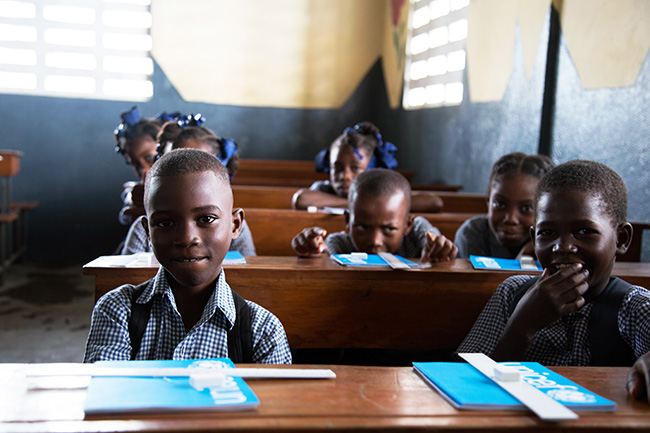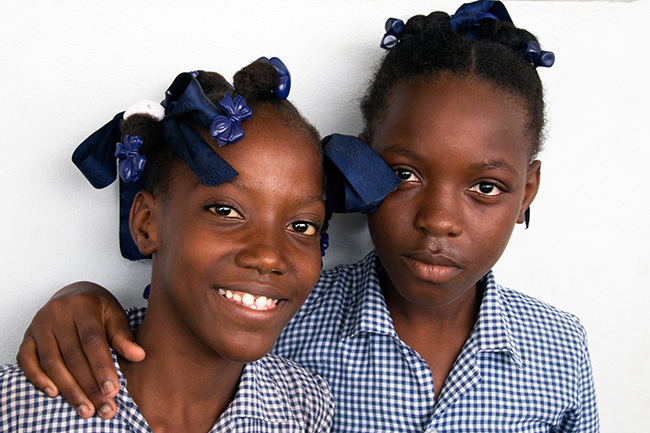(只有英文)飓风马修吹袭后 儿童重返校园
2016-11-16
© UNICEF/UN047536/Bradley
(只提供英文版本)
By Pedro Ivo AlcantaraMore than a month after Hurricane Matthew passed over Haiti, the hardest-hit areas are still recovering. In the town of Les Cayes, Ashleina and her friend Pauleta are excited to finally get back to class, even though their school has been partially damaged.

© UNICEF Haiti/2016/AlcantaraAt the École Nationale Charles Lassegue in Les Cayes, Haiti, students attend class with their new school materials, provided by UNICEF. Les Cayes is one of Hurricane Matthew hardest hit cities.
LES CAYES, Haiti/ HONG KONG, 16 November 2016 – “I am very happy to see my friends again and to be back to my school,” says Ashleina Jacques. She is a young girl, 10 years old, with ight eyes, and she cannot contain her joy. She has been waiting for what feels like such a long time.
Since Hurricane Matthew made landfall on 4 October, life has not been easy for the children of Les Cayes – a city in the South Department that is still recovering from the destruction left behind by the storm.
But Ashleina and her friend Saintyl Pauleta, 12, are happy to resume their education. The girls study in the École Nationale Charles Lassegue, which reopened on Monday, 18 October.
During the hurricane, the house where Ashleina lives with her parents and two sisters lost its roof, but remained standing. Pauleta’s house, however, was unable to withstand the heavy winds and ultimately collapsed. She lost everything, including all of her schoolbooks and supplies. Today she lives in one of the classrooms of her school, which now serves as a shelter to families left homeless by the hurricane.
Damaged schools
Just two weeks after the disaster, The Haitian Ministry of Education began reopening schools in the worst hit departments of the country. More than 700 schools were affected and about 86 schools are being used as temporary shelters, causing school disruption for around 150,000 children.
It is estimated that in the South Department, where Ashleina and Pauleta live, 126 public schools have been seriously damaged. In the Grande Anse Department, 209 public schools have been affected, with 107 of them sustaining heavy damage.
The École Nationale Charles Lassegue has reopened, even though one of its buildings was severely damaged by the storm and most of its teaching materials and supplies have been lost or damaged. Some classrooms have become provisional shelter for displaced families like Pauleta’s.

© UNICEF Haiti/2016/AlcantaraAshleina (left), 10, stands with her friend Pauleta, 12. "I am very happy to see my friends again and to be back to my school," says Asheina.
Before the hurricane, the school had 447 students. Now, 113 children from nearby damaged schools have also been temporarily enroled.
“Many of my students lost everything, their houses, their clothes and also their school materials,” says Micheline Nogaüs Joujoute, the principal of the school.

© UNICEF Haiti/2016/AlcantaraChildren gather outside the École Nationale Charles Lassegue. One of the school buildings was severely damaged by the storm and most of its teaching materials and supplies have been lost or damaged. Some classrooms have become provisional shelter for displaced families.
UNICEF response
UNICEF is supporting the Ministry of Education in the hurricane-affected areas by refurbishing schools, including ensuring suitable WASH facilities; providing furniture like benches, tables and blackboards; providing school kits to children; and providing teaching kits to teachers.
With the support of UNICEF, 1,096 affected children, including 400 preschool-aged children and 30 teachers in the South Department received school supplies just 15 days after the hurricane.
“UNICEF and partners are working with national counterparts to find sustainable alternatives for people temporarily accommodated in schools, while at the same time working to ensure repairs of water and sanitation infrastructure in anticipation of resumption of education activities,” says Marc Vincent, UNICEF Haiti Representative.
Recovering
For children affected by emergencies like Ashleina and Pauleta, being back at school is significant. It is one of the most important steps towards helping them deal with the stress of the situation and get back the joy of being a child.
As one teacher remarked, “After the hurricane, they were traumatized and sad. Now that they are going to school, they are smiling again.”

© UNICEF Haiti/2016/Alcantara Children attend class with their new school materials, provided by UNICEF. Most schools in Haiti's hardest hit areas reopened just two weeks after the storm.









